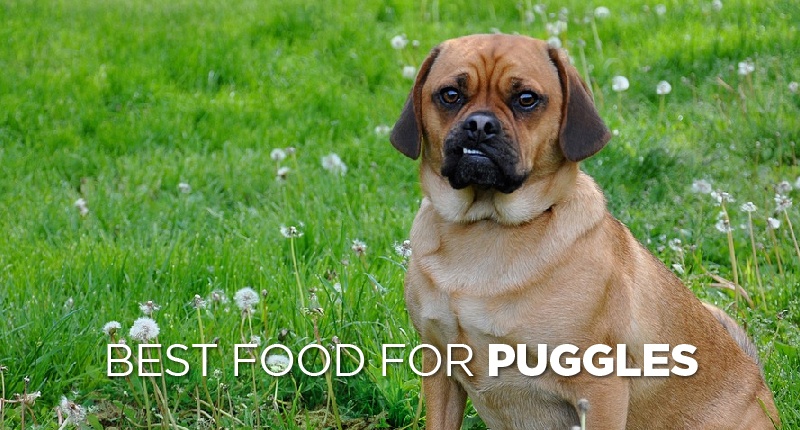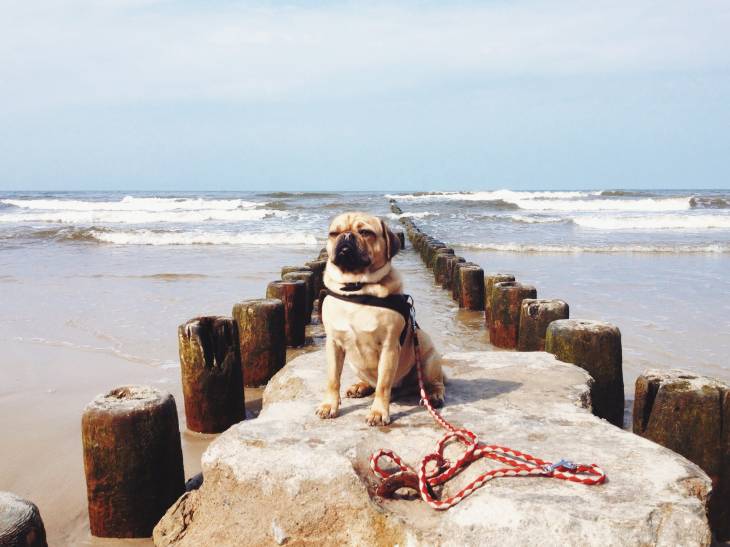New Dog, Old Needs: The Best Dog Food For Puggles

Since the 1990s when they were first bred, Puggles have skyrocketed in popularity. But what’s the best dog food for Puggles? What do you feed a dog that’s small, yet agile and energetic at the same time? Luckily, we’ve done some research—and here’s what we found out.
Our Favorite Picks for Puggle Dog Food
**There's more info below, but you can also click the links above to see current prices or read customer reviews on Chewy.
**Disclaimer: Our dog food reviews are based mostly on (1) our expertise and that of the experts with whom we consult and (2) the information provided by the manufacturers. We do test many dog foods (with our dog's help), but we can't test them all. As such, please remember the above recommendations are our opinions, and you should consult your vet before making changes to your dog's diet.
How Much Should You Feed a Puggle?
**Please note: these estimates are based on an average weight for this breed. Every dog is different. Please talk to your vet before making changes to your dog's diet.
Puggles grow to a height of about 1 foot, 2 inches, and can weigh anywhere from 18 to 30 pounds. As a smaller, yet still very energetic dog breed, it’s important that they receive a sufficient number of calories to get them through the day—though it’s also important that these calories are made up of healthy, nutritious foods. Cheap dog food from the retail store probably isn’t a great idea with this breed, as it tends to be made up of filler materials and lacks the vital nutrients that the breed needs to thrive.
A less-active Puggle will require about 540 calories on a daily basis to stay energized and healthy, while a moderately-active dog of this breed will require a bit more—somewhere around 660 calories. If your dog is highly active, gets more exercise than normal, or gets a lot of high-energy outdoor time, then you might find yourself feeding as many as 1050 calories on a daily basis.
Just remember that every dog’s needs will be a little bit different, so try to keep that in mind as you feed. Does your dog always leave food in the bowl? Is he/she gaining more weight than is healthy? If so, then you might want to cut back on the number of calories.
On the other hand, a dog that always seems hungry or low on energy might actually need a bit more to eat. It might also be a good idea to split up feedings over the course of the day instead of all at once—though, once again, this depends on the dog and on your personal routine.
20% off at chewy.com
On ALL dog food.
Basic Puggle Nutritional Requirements
Puggles, like any other dog, have basic nutritional requirements that are important to keep in mind.
First of all, they’re energetic—so be ready to take a few walks or to ensure some outdoor playtime to keep your dog healthy, happy, and fit. They can also be prone to obesity—so try to feed in two or three different meals instead of leaving food out all day long, and make sure to measure their daily caloric intake so that they don’t eat too much.
For coat and joint health, Puggles need healthy amounts of Omega fatty acids. They also need vitamins—especially vitamins C and E, which will help to prevent Hypothyroidism.
Healthy fats and amino acids are also critical to this dog breed. This article, published by bark.com, actually does a great job of summarizing basic nutritional requirements for dogs—and can be an awesome reference if you have any specific questions regarding this topic.
Common Health Problems
Puggles tend to be pretty healthy pets overall—but they’re still prone to a few basic health problems. Since they sometimes inherit the shorter nose of their Pug lineage, it’s possible that some breathing problems will occur. Keeping your dog lean and healthy should do a lot to help prevent any possible breathing problems caused by the shape of the nostrils, though sometimes surgery is the only possible means of correction.
Besides these, there are a few other potential health challenges to keep an eye out for.
Hypothyroidism
According to this article on peteducation.com, hypothyroidism results from…
“…the impaired production and secretion of thyroid hormones.”
Some side effects of the condition include lethargy, hair loss, mental dullness, weight gain, excessive shedding, hyperpigmentation of the skin, cold intolerance, and more. Dogs with hypothyroidism will need to be treated by a vet, but it is possible to help prevent the condition with a high quality diet that’s rich in Omega Fatty Acids, vitamins, and minerals. Keeping your dog lean and within the proper weight range can also help.
Stenotic Nares
This is actually a congenital disorder that’s also known as ‘pinched nostrils’. Dogs with shorter muzzles tend to deal with it more. It basically makes it more difficult for the animal to breathe.
One of the best ways to deal with this problem is to keep your dog lean and healthy. Obesity will make any breathing problem worse. Sometimes, however, the only remedy for this condition is surgery.
Hip Dysplasia
This condition affects the joints, and basically occurs when the thighbone doesn’t fit as well into the hip joint. Some possible symptoms include lameness in one or both rear legs, discomfort, leg pain, and limping.
While Hip Dysplasia is a genetic condition, it might be possible to help prevent it with a good, easily-digestible, high-quality diet—especially if it contains healthy amounts of the vitamins C and E and quality Omega Fatty Acids.
This article does a great job of discussion Hip Dysplasia from a holistic, dietary viewpoint.
How To Feed A Puggle Puppy

To give it the best possible chance at a healthy, happy, functional life, it’s recommended that you make sure to adequately socialize your Puggle—especially during the first 8 to 9 weeks of life. Puggle puppies generally begin the weaning process about 4 to 5 weeks after birth. This process can be helped by supplementing their mother’s milk diet with goat milk and rice cereal.
Very soon after this (4 to 5 days after they begin weaning), you can introduce some puppy food—though it might take a couple of weeks for it to really catch on, so keep feeding rice cereal and goat’s milk until it does. This breed doesn’t usually finish weaning until sometime around week 6, so don’t worry if they don’t jump right into the puppy food at first.
Weeks 6 through 7 are very important for Puggles. This is a crucial time for socialization, and will also be the prime time for their first visit to the veterinarian. By week 8, most puppies of this breed are ready for adoption, and can be safely removed from their litter to begin their new life with their adopted families.
Puggle puppies generally weigh somewhere around 4 pounds by the time they’re 8 weeks old. At this age, they’ll probably need somewhere close to 170 calories per day to stay energized.
The Best Food for Puggles: Our Recommendation
We’ve done a lot of searching and researching to answer this question, and have come up with more than a few awesome possibilities (see our list above for our top 4 pics). There are a lot of awesome dog foods out on the market nowadays—but in our minds, Canidae Grain Free Pure Elements Dry Dog Food really stood out from the rest.
Canidae Grain Free Pure Elements really packs everything that Puggles need into one amazing dry dog food formula. Fresh lamb is the number one ingredient, but it also contains menhaden fish meal—which is an excellent source of Omega 3 Fatty Acids. Omega 3 is vitally important to many of the health needs of the breed. It’ll help to prevent Hip Dysplasia and Hypothyroidism in Puggles—among other diseases and conditions.
This dog food formula also contains Vitamin E supplementation, as well as a number of other vitamins, minerals, and amino acids. It’s also gentle on the digestive tract, and is grain, gluten, corn, wheat, and soy free!
Pros and Cons
- Rich Omega 3 and 6 fatty acid content
- Gluten, wheat, soy, and corn free
- Contains key vitamin E supplementation to support joint health
- Contains sun-cured alfalfa, which is considered filler by some
- While it can be ordered online, it can be difficult to find at a local store
If you’re looking for an awesome, grain-free, dry dog food option that’ll give your Puggle what he or she needs to thrive, then you really can’t go wrong with Canidae Grain Free Pure Elements Dry Dog Food. It’s simple, natural, healthy, and contains whole-food nutrients that’ll keep your favorite canine companion happy, healthy, and going strong!
Image credit: Chewy.com, https://www.flickr.com/photos/tinto/


